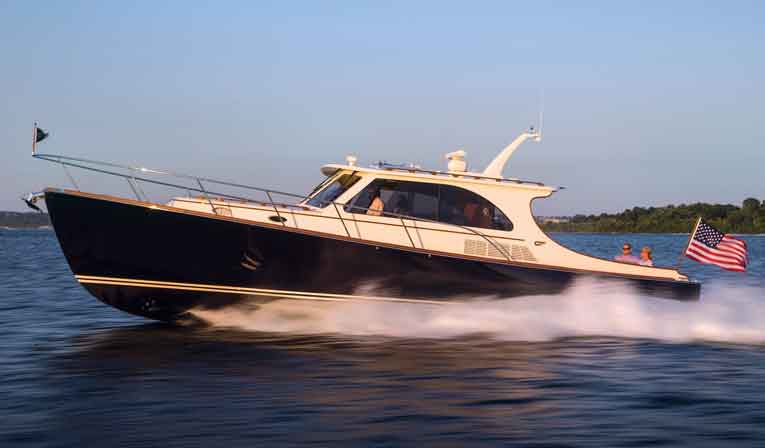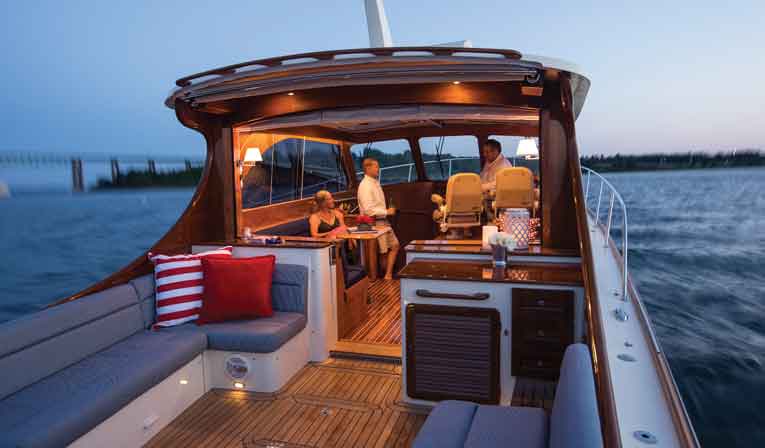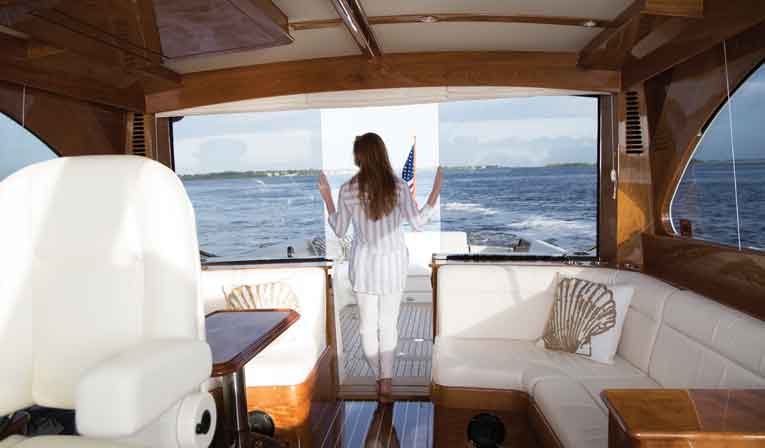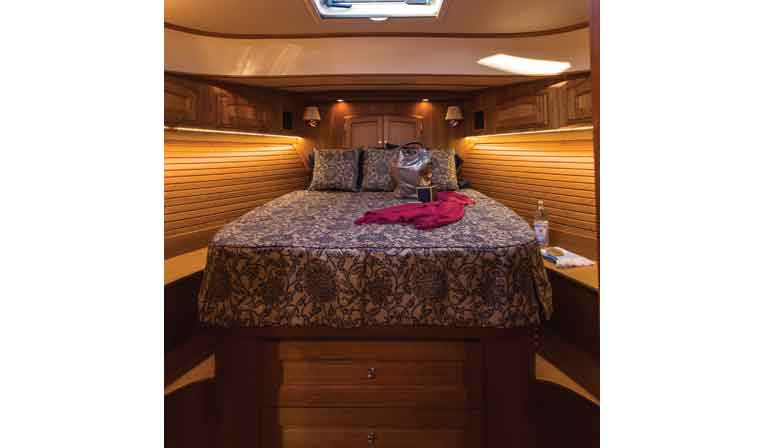American pride.
by Alan Wendt
Inspired luxury. Minimalistic, yet technologically advanced. Hinckley’s Talaria 43 is one yacht I didn’t mind taking my boat shoes off in order to board.
Seduced by gleaming cherry and a time-honored cabin sole of teak and tulipwood in gloss varnish, the Talaria 43 creates an aura of reverence, beckoning you to discreetly slide into a cushioned pew, breathe the sea air deeply and slowly take an account of the amazing surroundings.
Honestly, I expected the Dos Equis “most interesting man in the world” to climb aboard during our sea trial. The owner’s name and hail port in 22-karat gold vinyl popped from the transom, complete with an unfurled red, white and blue ensign that neatly complemented the Awlgrip painted hull.
Four inflatable fenders protecting that finish from dock rash quickly moved into position and secured to strategically located fastening clips that run the length of the hull.
Unlike most boat tests, no one rushed to start the engines, let alone spin up the Seakeeper Gyro; instead, Eric Champlin, Hinckley’s senior sales director, and I just sat down and began a mind-wandering conversation about family, shared experiences, values, boat building techniques, the merits of Hamilton waterjets and you — the next Hinckley owner.
Top of the line
Hinckley makes about 50 of these boats a year, and while no two owners are the same, some demographics are revealing. You are a person with means: With a base price of $1.6 million, this sporty, open-air express is not your typical entry-level runabout.
Patient. Each Hinckley is commissioned, and for this model that means at least six months.
Performance driven. Twin Cummins QSB 550s deliver a 34-knot, wide open boat with a cruising speed of 29 knots.
Precise. Control is provided by Hinckley’s latest generation of Jetstick. More than joystick technology, Jetstick II enhances the driving experience by governing power with smooth, proportional control. Actually, that’s quite a feat; unlike propeller-driven pods or outboards we typically see connected to a joystick, Talaria uses waterjets with sophisticated buckets in concert with a forward thruster. This updated model adds virtual anchoring and heading hold, ideal for single-handed cruising.
You love gadgets. Admit it: There’s a bit of James Bond in all of us, and for Talaria there are three distinct push button-controlled innovations that will add to your legend. We might call the first a parlor trick, since it involves the motoryacht’s salon. Swept glass windows and the sliding door that form the secure aft enclosure electrically retract into the port and starboard cabinetry. In seconds, living and entertaining space stretches from the helm to the transom. That’s simple enough if the glass is straight, but on a Hinckley the DTS glass panels are curved; they have to disappear below deck, meaning no engine or mechanical parts in the way. On a boat with a scant 28-inch draft, that, my friends, is a magic trick. By the way, this patent-pending system was manufactured in Detroit.
In addition to Jetstick II, the Talaria 43 has an optional helm accessory to keep operations easy: A handheld remote control known as PalmStick. For those rare occasions where the helm does not offer the best view, like backing into a narrow slip, or picking your way up a tricky channel made difficult by low water or shoaling, PalmStick allows you to drive wherever the vantage point seems best. In simplest of terms, it’s like a wireless video game controller.
Rest and relaxation
One of the secrets to matrimonial bliss, at least on the water, is ensuring that your passengers are comfortable underway. Stowed in the sole of the Talaria 43 is the newest generation of gyro stabilization from Seakeeper. We tested this model inland and then ran outside into 3-foot waves. Cycling the gyro on and then off several times clearly demonstrated the effectiveness of mitigating the uncomfortable effects of rolling side-to-side by some 70 percent or more.
Since most customers use this boat for entertaining, and many guests may not be mariners, Hinckley devoted great thought into eliminating boarding embarrassment. A Bo Peep handrail identifies a side-boarding door, with molded step with teak tread below the coaming door on the starboard side. All lines, shore power cables and water hoses are out of the way.
Settee seating for eight in the cockpit, arranged in a traditional “L” shape, and a hospitality center to starboard would provide enough entertainment for most — but then you’d be missing the best part of this yacht.
The single-level cockpit and salon create an easy flow between the two spaces. A full portside galley is opposite the helm — in short, all refreshments are close at hand. Our test boat galley was finished completely in cherry, making the sink, stovetop and pullout drawer refrigerator/freezer indistinguishable. Most owners opt for a Corian countertop; yet semi-custom work is one of the differentiators of the Hinckley product.
For a traditional looking boat, the helm was amazingly high-tech. Two color multi-function displays created a visual array of information we’ve come to rely on. Separate system monitoring devices round out the independent displays, while Hinckley’s Onwatch remotely monitors bilge, security, shore power, batteries, location and critical engine data. Authorized technicians, helping to minimize a mechanics time, can perform diagnostics for engine and control systems remotely.
Neatly recessed into the helm side panel along the stairs leading below to the cabin and head, is a smart-looking distribution panel with easy to understand sections for 24-volt DC and 120/240VAC breakers and amp meters.
The forward berth serves as the master, featuring a centerline berth with innerspring mattress, while the double guest cabin offers adequate yet modest overnight accommodations. Both share the portside head and separate molded fiberglass shower enclosure with teak seat.
Pods or Jets?
Hinckley introduced waterjet propulsion on its first Picnic Boat in 1994. Near home port in Trenton, Maine, where the production facility is located, lobster traps are a never ending mine field to navigate. A Downeaster design and jets made sense to scoot over the surface without fouling traditional props. The idea spread along with Hinckley’s footprint of service yards and delivery centers that now stretch from Irish Boat Shop in the Great Lakes along the Atlantic seaboard and up into the Gulf Coast at Naples.
As part of the Hinckley ownership experience, owners get a three-day orientation that includes day and night operation on the water and, depending on your interest, a DIY course in systems in a neatly organized, well labeled bilge. Waterjets have few moving parts, are tireless workhorses on many Navy vessels and come with a five-year warranty.
This is the first model Hinckley has offered with Volvo IPS 600 pod drives as an option from inception. The difference? At low speed, props win the fuel economy proposition, while jets claim top honors at speed. One can argue over maintenance costs for either, just know that both require periodic service, as do all boats. A measurable difference may be in where and how you plan to enjoy this boat. Like many Midwesterners, Florida beckons about the time the first snowflakes arrive. With a jet drive and low profile, this is a very easy boat to transport by truck, with little make-ready time upon arrival.
Bottom line, handling is straight as an arrow, a true centerline course; it’s extremely easy to master docking with Jetstick II fingertip control. This is precision craftsmanship second to none — a stirring example of what makes America great.
Specifications
- LOA: 43’9″
- Beam: 14’6″
- Draft: 2’4″
- Weight:
- Fuel Capacity: 500 gals.
- Water Capacity: 100 gals.
- Power: T-Cummins QSB 550 hp 6.7 liter, T-Hamilton 322 jet drives
- Price: Contact dealer
- Website: hinckleyyachts.com
Photo Courtesy of Hinckley
Photo Courtesy of Hinckley
Photo Courtesy of Hinckley






